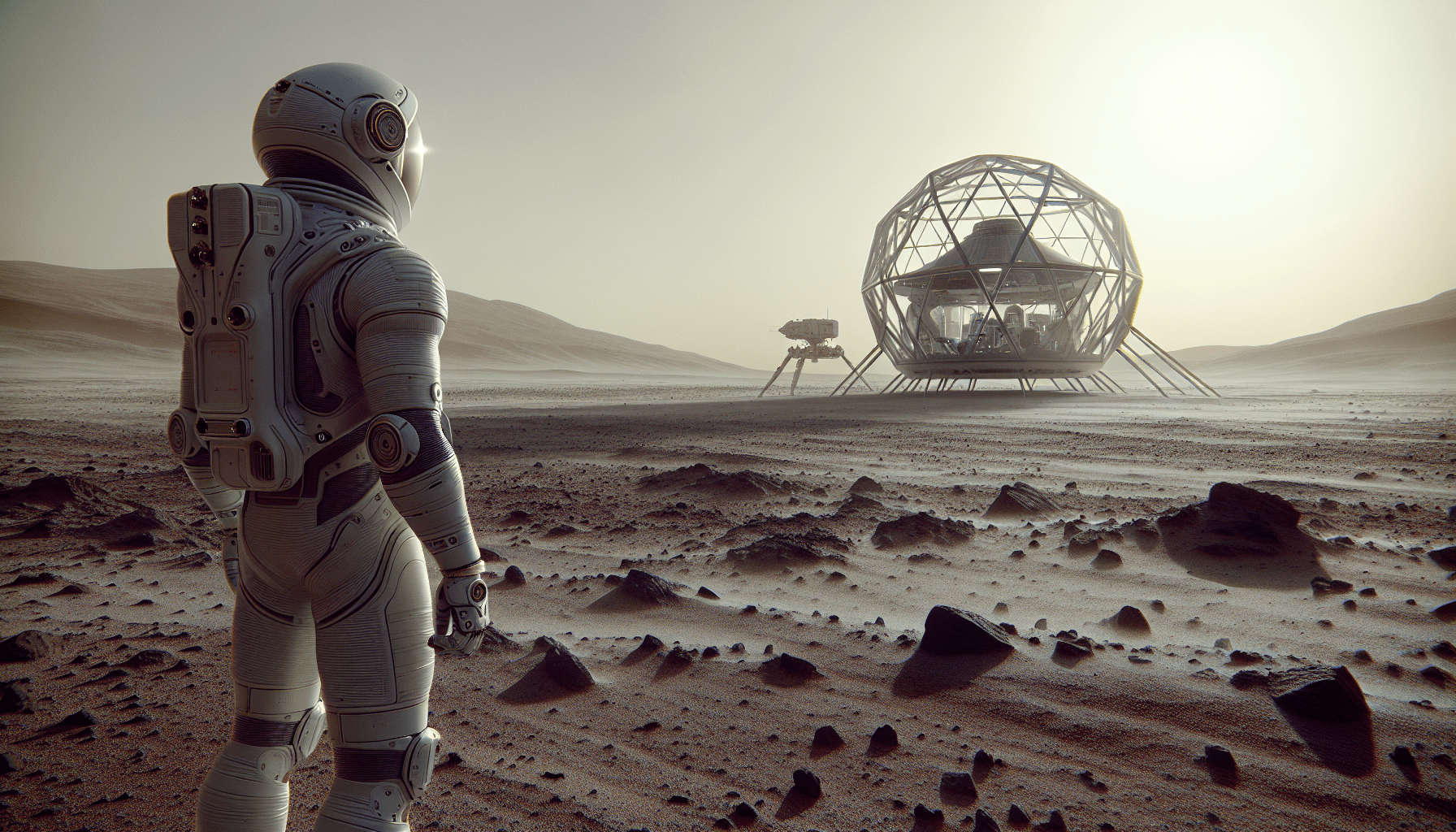FLASHFORGE 3D Printer AD5M, CoreXY 600mm/s High-Speed Printer with 1-Click Auto Leveling, High-Temp Direct Drive Extruder, 3s Quick-Swap Nozzle, 220×220×220mm Build Volume
$259.00 (as of June 19, 2025 23:45 GMT +00:00 - More infoProduct prices and availability are accurate as of the date/time indicated and are subject to change. Any price and availability information displayed on [relevant Amazon Site(s), as applicable] at the time of purchase will apply to the purchase of this product.)NASA is embarking on a search for volunteers to participate in a year-long Mars simulation in a 3D printed habitat. The program, known as the CHAPEA mission, aims to simulate the conditions that astronauts would experience in a real Mars habitat. The four-person crew will live in a 1700sf habitat located in Houston at the Johnson Space Center, following a day-night schedule based on “Mars Time” and communicating with Earth with a delay corresponding to the light time delay between the two planets. By conducting this experiment, NASA hopes to identify any potential issues that may arise in a future Mars habitat and further prepare for the first human journey to Mars. If you meet the requirements and are up for a unique and rewarding adventure, applying for this job might just be the opportunity of a lifetime.
Overview of NASA’s Year-Long Mars Simulation
Background of the CHAPEA Program
NASA’s Crew Health and Performance Exploration Analog (CHAPEA) program aims to simulate the conditions of a Mars habitat to prepare for future human missions to the red planet. The program utilizes a 3D printed habitat called Mars Dune Alpha, which was constructed by ICON, a leading construction 3D printing company. The CHAPEA program has already completed one successful mission and is now seeking volunteers for its second year-long Mars simulation.
Purpose of the Mars Simulation
The primary purpose of the Mars simulation is to identify and address any potential issues that could arise in a real Mars habitat. By simulating the conditions and challenges that astronauts may face on Mars, mission designers can test their plans and make necessary improvements. This simulation will provide valuable insights into the operational, technical, and psychological aspects of living on Mars, allowing for better preparation for future missions.
Details of the Mars Habitat
The Mars Dune Alpha habitat is a 1700 square foot structure located at the Johnson Space Center in Houston. It is designed to closely resemble a real Mars habitat and provides a realistic living environment for the crew. The habitat was entirely 3D printed, showcasing the advancements in construction 3D printing technology. It is equipped with all the necessary facilities and supplies for the crew to sustain themselves for a year.
Location and Duration of the Simulation
The year-long Mars simulation will take place at the Mars Dune Alpha habitat in Houston. The selected crew of four individuals will reside in the habitat for the entire duration, experiencing life as if they were on Mars. The simulation will follow a day-night schedule based on “Mars Time,” which has a slightly longer day than Earth. All communication with mission control and the outside world will have a delay to simulate the light time delay experienced between Mars and Earth.
Importance of the Simulation
Identification of Potential Issues
One of the key benefits of the Mars simulation is the identification of potential issues that would otherwise only be discovered during actual missions to Mars. By living in the simulated habitat for a year, the crew members will encounter challenges in areas such as resource management, communication delays, psychological effects of isolation, and managing emergencies. Identifying and addressing these issues will greatly enhance the preparedness and safety of future Mars missions.
Improvement of Mission Design
The simulation will also provide invaluable data and insights for mission designers, allowing them to make improvements to their plans and strategies. By observing the crew’s experiences and feedback during the simulation, NASA can make necessary adjustments to ensure the success of future Mars missions. This includes fine-tuning technical aspects, optimizing resource allocation, and improving communication protocols.
Preparation for Future Mars Habitat
Living in a simulated Mars habitat for a year will equip the crew and NASA with the knowledge and experience necessary to build and operate future Mars habitats. The insights gained from this simulation will contribute to the development and improvement of technologies and systems required for long-duration space travel and colonization. This preparation is crucial for ensuring the safety, well-being, and success of future astronauts who will embark on the journey to Mars.

Requirements for Volunteers
Health and Age Criteria
To participate in the Mars simulation, volunteers must be healthy, motivated U.S. citizens or permanent residents between the ages of 30 and 55. This age range is selected to ensure that the crew members are in their prime physical and mental condition to handle the challenges of living in a Mars-like environment. Additionally, volunteers must be non-smokers to prioritize their health during the simulation.
Proficiency in English
Effective communication is vital for the success and safety of the crew during the Mars simulation. Therefore, volunteers must be proficient in English to facilitate clear and concise communication between crewmates and mission control. This requirement ensures efficient coordination and problem-solving while in the simulated habitat.
Educational and Professional Qualifications
Volunteers for the Mars simulation must possess a minimum of a Master’s degree in a STEM discipline or have at least 1000 hours of aircraft piloting experience. These qualifications ensure that the crew members have a strong foundation in scientific knowledge and problem-solving skills. The aircraft piloting experience requirement emphasizes the ability to handle complex and high-pressure situations, which are crucial for the success of the mission.
Benefits for Volunteers
Unique and Rewarding Experience
Participating in the year-long Mars simulation offers volunteers a once-in-a-lifetime opportunity to experience life in a simulated Mars habitat. The challenges and adventures of emulating the conditions of another planet will provide an unparalleled sense of accomplishment and personal growth. Living and working in a closely-knit team under demanding circumstances will forge strong bonds and create enduring memories.
Contributing to NASA’s Work
Volunteers for the Mars simulation will have the chance to directly contribute to NASA’s ongoing efforts to explore and prepare for human missions to Mars. By participating in this simulation, volunteers become an integral part of NASA’s research and development process. Their experiences, feedback, and insights will shape the future of space exploration and ensure the successful colonization of Mars.
Opportunity to Live in a 3D Printed Habitat
Living in a 3D printed habitat is a groundbreaking experience in itself. Volunteers will have the unique privilege of residing in the Mars Dune Alpha habitat, which showcases the advancements in construction 3D printing technology. This opportunity allows volunteers to witness the practical application of 3D printing in space exploration and contribute to the further development of this innovative technology.

Application Process
Submission of Application
To apply for the Mars simulation, interested individuals must submit a comprehensive application to NASA. The application will require personal information, educational and professional qualifications, and a statement explaining their motivation for participating in the simulation. Candidates will also need to provide references who can vouch for their character and abilities.
Screening and Selection
The submitted applications will undergo a rigorous screening process to assess the suitability of each candidate. This screening process may involve interviews, medical examinations, and evaluations of the candidates’ qualifications. Successful applicants will demonstrate their strong motivation, physical and mental fitness, and compatibility for living and working in a team-based, isolated environment.
Notification of Acceptance
Once the selection process is complete, NASA will notify the accepted volunteers of their successful application. They will receive detailed information on the next steps, including pre-mission training and preparation. For those who are not selected, NASA will provide feedback or suggestions for further consideration in future missions.
Expectations and Responsibilities
Living Conditions during the Simulation
During the Mars simulation, volunteers will experience living conditions that closely resemble those on Mars. They will have limited personal space and resources, requiring effective time and resource management. The habitat will be designed to replicate the environmental conditions of Mars, including temperature variations, limited natural light, and a controlled atmosphere. Volunteers should be prepared for a challenging but rewarding experience in an environment that simulates the harsh conditions of another planet.
Adherence to Schedule and Supplies
To ensure the accuracy of the simulation, volunteers must strictly adhere to the day-night schedule based on “Mars Time.” This means adjusting their daily routine to match the slightly longer Mars day. Additionally, the crew members must rely solely on the supplies provided to them. This includes food, water, and any necessary equipment or tools. The limitations on resources aim to replicate the scarcity and self-sufficiency that would be encountered on a real Mars mission.
Communication with Mission Control
Clear and effective communication between the crew and mission control is crucial for the success of the mission. Volunteers will be expected to regularly communicate with mission control to provide updates, report any issues or concerns, and receive instructions. Communication protocols will be in place to ensure efficient and accurate transmission of information, despite the intentional delay to simulate the distance between Earth and Mars.
Compensation and Benefits
Payment for Participation
Volunteers selected for the Mars simulation will be compensated for their participation. The exact payment details will be discussed with the accepted candidates upon notification of acceptance. This compensation serves as a recognition of the dedication, commitment, and valuable contributions of the crew members during the year-long simulation.
Accommodation and Food
Volunteers will be provided with accommodation within the Mars Dune Alpha habitat for the entire duration of the simulation. The habitat, which was 3D printed by ICON, offers a comfortable and functional living space. All necessary facilities, including sleeping quarters, bathrooms, and community areas, will be available to the crew. Additionally, NASA will ensure that nutritious and sufficient food supplies are provided throughout the simulation.
Healthcare and Support Services
The well-being and safety of the crew members is of utmost importance during the Mars simulation. NASA will provide comprehensive healthcare support, including regular medical check-ups, access to necessary medications, and emergency response protocols. Psychological support services will also be available to ensure the mental and emotional well-being of the volunteers throughout their stay in the simulated habitat.
Previous Expeditions and Successes
Overview of the First CHAPEA Crew
The first CHAPEA mission was successfully conducted with a crew of four individuals who lived in the Mars Dune Alpha habitat for a year. This inaugural expedition provided valuable insights into the challenges and requirements of sustaining human life in a Mars-like environment. The crew members demonstrated exceptional teamwork, adaptability, and problem-solving skills, setting a strong foundation for future missions.
Lessons Learned and Improvements
The first CHAPEA mission allowed NASA to identify areas for improvement and make necessary adjustments for the second expedition. Lessons learned from the inaugural simulation guided the refinement of mission protocols, habitat design, crew selection criteria, and training programs. The feedback and experiences of the first crew were invaluable in enhancing the future success and safety of the Mars simulations.
Implications for Future Missions
The knowledge gained from the CHAPEA program’s Mars simulations will significantly contribute to future Mars exploration missions. The insights and data collected during the simulations will inform the development of technologies, strategies, and systems required for long-duration space travel and human colonization. The successful completion of the simulations will pave the way for the first human journey to Mars, ensuring the feasibility and sustainability of future missions.
Public Interest and Impact
Opportunities for Education and Outreach
The Mars simulations conducted by NASA generate significant public interest and provide valuable educational opportunities. The program offers a chance for the public to engage with space exploration on a deeper level, fostering curiosity and interest in science, technology, engineering, and mathematics (STEM) fields. NASA actively promotes educational outreach programs to inspire the next generation of scientists, engineers, and explorers.
Inspiring the Next Generation
By witnessing the achievements and challenges of the Mars simulations, young individuals are inspired to pursue careers in space exploration and related fields. The experiences and stories of the volunteers and their contributions to NASA’s work serve as a powerful motivator for aspiring astronauts, scientists, and engineers. The simulations act as a catalyst for curiosity-driven learning and encourage the pursuit of innovative solutions to space exploration challenges.
Advancements in 3D Printing Technology
The use of 3D printing technology in the construction of the Mars Dune Alpha habitat showcases the advancements and potential applications of this innovative technology. Living in a 3D printed habitat not only provides an immersive experience for the volunteers but also drives further research and development in the field of construction 3D printing. The success of the simulations will likely contribute to the refinement and expansion of 3D printing capabilities for future space missions.
Conclusion
Final Thoughts on NASA’s Mars Simulation
NASA’s year-long Mars simulation program offers a unique and rewarding opportunity for volunteers to participate in the exploration and preparation of future missions to the red planet. The simulations play a crucial role in identifying potential issues, improving mission design, and preparing for the establishment of a Mars habitat. Volunteers will contribute directly to NASA’s work, live in a 3D printed habitat, and gain invaluable knowledge and experience. This program ignites public interest, inspires the next generation, and advances the capabilities of 3D printing technology. With each successful simulation, we come closer to fulfilling the dream of human exploration and colonization of Mars.
Potential for Future Mars Exploration
The insights, advancements, and preparations gained from the Mars simulations pave the way for the realization of future Mars missions. The CHAPEA program serves as a stepping stone towards the first human journey to Mars, ensuring the success, safety, and sustainability of such missions. As NASA continues to refine its strategies and technologies, the simulations act as a catalyst for innovation and inspire the collaborative efforts of scientists, engineers, and visionaries. With the dedication and contributions of volunteers, the dream of Mars exploration becomes closer to reality.










